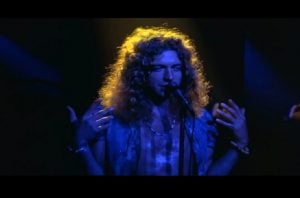All The Rock Legends We Lost So Far In 2025

Via USA TODAY / YouTube
Time has a way of catching even the most enduring legends. As 2025 continues to unfold, the rock and metal world has already been met with a string of painful goodbyes—each one a reminder of how deeply these musicians shaped the sounds and stories of generations. From trailblazers to unsung heroes, their departures mark the end of irreplaceable chapters in music history.
These weren’t just names in liner notes or faces on record sleeves. Each of them brought something distinct to the stage—be it a sound, a vision, or an energy that turned ordinary notes into cultural touchstones. Whether they stood front and center or quietly redefined their roles behind the scenes, their impact resonates in every riff, lyric, and live show that came after.
Some were pioneers of entire movements. Others quietly held their bands together with unmatched skill. From Garth Hudson’s sweeping contributions to The Band’s iconic sound, to the gritty magic of John Sykes’ guitar work, to Mike Peters’ defiant voice in the face of illness—2025 has already asked rock fans to say goodbye to more than a few giants.
Garth Hudson (The Band)
Garth Hudson, best known as the quiet genius behind The Band’s iconic sound, passed away on January 21 at the age of 87. As the last surviving member of the influential Rock and Roll Hall of Fame group, Hudson’s death symbolized the end of an era that helped shape the roots-rock movement. He died peacefully in his sleep after a prolonged illness, leaving behind a legacy of deeply emotional and musically complex performances.
Before finding fame with The Band, Hudson played alongside Levon Helm in Ronnie Hawkins’ supporting act, The Hawks. His innovative approach to the organ, piano, and saxophone gave The Band a distinctive voice that set them apart from their contemporaries. In many ways, Hudson was the band’s secret weapon—capable of shifting seamlessly between genres and imbuing their songs with a haunting beauty.
The accolades that followed were well deserved. The Band’s contributions earned Hudson spots in the Rock and Roll Hall of Fame and the Canadian Music Hall of Fame. He was also awarded a Grammy Lifetime Achievement Award and inducted into Canada’s Walk of Fame. Despite his quiet demeanor, Hudson’s work echoed far and wide, cementing his place in the pantheon of rock innovators.
View this post on Instagram
John Sykes (Thin Lizzy, Whitesnake, Blue Murder)
John Sykes, the hard-hitting guitarist behind some of rock’s most anthemic riffs, died on January 20 at the age of 65. His death, the result of a private battle with cancer, was confirmed in a heartfelt statement that praised not just his musical talent but also his charisma and warmth. Known for his flair and technical prowess, Sykes left a mark on several major rock acts of the ’70s and ’80s.
Sykes made his name with Thin Lizzy, contributing heavily to their final album Thunder and Lightning alongside frontman Phil Lynott. He then joined Whitesnake, helping reinvent their sound for a global audience with tracks like “Is This Love,” a smash hit from their multi-platinum self-titled album. His guitar work on these records remains some of the most revered in ’80s hard rock history.
Though his relationship with Whitesnake’s David Coverdale was rocky, Sykes’ contributions were undeniable. He also fronted his own band, Blue Murder, and performed with Tygers of Pan Tang, leaving behind a rich, varied discography. For fans and fellow musicians alike, Sykes was a beacon of guitar excellence and an enduring symbol of rock’s melodic edge.
View this post on Instagram
Marianne Faithfull
Marianne Faithfull, the smoky-voiced chanteuse of the 1960s, died on January 30 at the age of 78. Rising to fame with the haunting hit “As Tears Go By,” Faithfull became a staple of the British Invasion era, her voice forever linked to the era’s most emotionally charged songs. The tune was penned by Mick Jagger, Keith Richards, and Andrew Loog Oldham, marking her deep musical ties to The Rolling Stones.
Beyond her well-known relationship with Jagger, Faithfull forged a career that blended folk, pop, and art rock into something uniquely her own. Tracks like “Come and Stay With Me,” “This Little Bird,” and “Summer Nights” showcased her early pop charm, while later appearances—such as her collaboration with Metallica on “The Memory Remains”—reflected her enduring presence in modern rock.
Faithfull also enjoyed a diverse acting career, appearing in films like The Girl on a Motorcycle and Hamlet, as well as on stage in acclaimed theatrical productions. Her creative versatility and unfiltered authenticity turned her into a true icon—not just of rock, but of resilience. She was never content with fading quietly into history, and instead kept finding new ways to surprise and challenge her audience.
View this post on Instagram
David Johansen (New York Dolls, Buster Poindexter)
David Johansen, a magnetic figure who bridged glam, punk, and lounge, died of cancer on February 28 at age 75. As the flamboyant frontman of The New York Dolls, he helped usher in the era of punk and inspired countless bands with his gritty, theatrical stage presence. Though the Dolls’ commercial success was limited, their cultural influence was massive.
Johansen’s career didn’t stop with the Dolls’ initial run. In the late ’70s and ’80s, he reinvented himself as Buster Poindexter—a suave, martini-sipping alter ego who brought him mainstream success with tracks like “Hot Hot Hot.” This unexpected transformation introduced him to a whole new generation and cemented his reputation as a chameleon capable of thriving in vastly different musical environments.
Acting was another avenue where Johansen thrived. He delivered standout performances in films like Scrooged, Let It Ride, and Tales From the Darkside, adding depth to a career already full of artistic turns. Whether in punk clubs, TV screens, or Broadway stages, Johansen brought bold personality and flair to everything he touched.
View this post on Instagram
Clem Burke (Blondie)
Clem Burke, the powerhouse drummer behind Blondie’s genre-defying sound, passed away on April 6 at age 70 following a private battle with cancer. Known for his unrelenting energy and dynamic rhythm work, Burke was more than just a drummer—he was the beating heart of Blondie, playing an integral role in the band’s most iconic moments.
From 1975 onward, Burke remained a core part of the band alongside Debbie Harry and Chris Stein. He contributed to every Blondie album, helping craft hits that blurred the lines between punk, pop, and disco. His unmistakable drumming can be heard on classics like “Heart of Glass” and “Call Me,” where his force and finesse elevated the songs beyond their catchy melodies.
Even after Blondie’s initial run ended, Burke continued making waves as a sought-after session player. He recorded with legends like the Eurythmics, Joan Jett, Pete Townshend, and Iggy Pop. He also joined bands like Dramarama and The Romantics, and even played briefly with the Ramones. Burke’s legacy is defined by versatility, creativity, and the kind of explosive energy that never seemed to fade.
View this post on Instagram
Les Binks (Judas Priest)
Les Binks, the former drummer for Judas Priest during their late ’70s ascent, died on April 15 at the age of 77. Though his time with the band was relatively brief, Binks played a crucial role in shaping their sound during a pivotal era. His contributions helped push Judas Priest toward the heavier, faster style that would later define classic British heavy metal.
Binks joined the group in 1977 just in time to tour in support of Sin After Sin, and he soon became a permanent fixture on two essential studio albums: Stained Class and Killing Machine (retitled Hell Bent for Leather in the U.S.). His drumming added a technical edge and a level of finesse that elevated the band’s sound. Many fans regard this period as one of Judas Priest’s most creatively rich eras.
After departing in 1979, Binks continued performing with other acts like Lionheart, Tytan, and Broken Bones, carving out a respectable post-Priest career. When Judas Priest was inducted into the Rock and Roll Hall of Fame, Binks was honored alongside his former bandmates—a testament to the lasting importance of his contributions during the band’s formative years.
View this post on Instagram
Mike Peters (The Alarm)
Mike Peters, the fiery voice and frontman behind The Alarm, died on April 29 at age 66 after a decades-long fight with cancer. Known for anthemic rock songs laced with political and personal urgency, Peters helped define college rock in the 1980s with hits like “Sixty-Eight Guns” and “Rain in the Summertime.” His stage presence and lyrical passion made him a standout voice in a sea of emerging alternative acts.
After leaving The Alarm in the early ’90s, Peters reinvented himself as a solo artist and later under The Alarm MM++ moniker, continuing to produce new material well into the 2000s. His work remained prolific and unwavering, a reflection of both his dedication to music and his refusal to let health setbacks define him. In total, he released more than a dozen albums in his later career.
Perhaps more inspiring than his music was Peters’ unrelenting spirit in the face of adversity. First diagnosed with lymphoma in 1995, and later chronic lymphocytic leukemia, he not only returned to the stage but launched the Love Hope Strength Foundation to support cancer awareness. His mountaintop charity concerts and advocacy efforts showed a man as committed to saving lives as he was to making music.
View this post on Instagram
Sly Stone (Sly & the Family Stone)
Sly Stone, the enigmatic genius behind Sly & the Family Stone, passed away on June 9 at the age of 82. His family shared the news with a touching statement, noting that Stone had battled COPD and other health complications before passing peacefully, surrounded by loved ones. Despite a career marked by turbulence, his legacy remains one of the most influential in the history of funk, soul, and rock.
Stone started his journey as a radio DJ and session musician in San Francisco, working with big names like Dionne Warwick and Marvin Gaye before forming his own group. With Sly & the Family Stone, he broke racial and gender barriers by assembling one of the first truly integrated bands in popular music. Their explosive blend of funk, rock, and psychedelia made them trailblazers of a new musical era.
Albums like Stand! and hits like “Everyday People” and “Thank You (Falettinme Be Mice Elf Agin)” captured the spirit of the late ’60s and early ’70s with both joy and urgency. Though the band split in 1975, and Stone struggled with addiction and personal setbacks afterward, his influence lived on through countless artists across genres. Sly Stone didn’t just lead a band—he created a movement.
View this post on Instagram
Brian Wilson (The Beach Boys)
Brian Wilson, the visionary force behind The Beach Boys, died on June 11 at the age of 82. The news was shared by his family shortly after the one-year anniversary of his wife Melinda’s passing. Wilson’s later years were marked by dementia and the appointment of conservatorship for his care, but the music he created across decades remains among the most celebrated in American pop history.
Wilson co-founded The Beach Boys with his brothers, cousin, and a friend, writing and producing much of their music. Albums like Surfin’ Safari and All Summer Long defined the early California sound, but it was 1966’s Pet Sounds that set Wilson apart as a sonic innovator. The album’s lush arrangements, unconventional structures, and emotional depth inspired generations—including contemporaries like The Beatles.
Despite personal battles with mental illness and substance abuse, Wilson continued to make music throughout his life. Later tours and solo projects reaffirmed his place as a musical giant. His devotion to harmony—both in sound and in life—made him a beloved figure to fans and peers alike. As Paul McCartney once said, Pet Sounds wasn’t just an album; it was an education in music and feeling.
View this post on Instagram
Peter Yarrow (Peter, Paul & Mary)
Peter Yarrow, the beloved folk singer and member of Peter, Paul & Mary, died on January 7 at age 86 after a long battle with bladder cancer. As one-third of the iconic ’60s trio, Yarrow helped create the soundtrack to a generation of civil rights activism and protest. His music, soft-spoken demeanor, and political commitment left a lasting imprint on American folk music.
Yarrow’s group rose to fame with heartfelt interpretations of songs like Bob Dylan’s “Blowin’ in the Wind” and their own original hits, including “Puff the Magic Dragon,” which Yarrow co-wrote. Their tight vocal harmonies and earnest lyrics brought folk into the mainstream and made the group a fixture at major protest events, including the 1963 March on Washington.
After the trio initially disbanded in 1970, Yarrow pursued solo work and remained deeply involved in political and educational causes. The group would occasionally reunite over the years, continuing to perform for causes they championed decades earlier. Yarrow’s life was defined not just by song, but by purpose—his legacy is one of compassion, conviction, and creativity.
View this post on Instagram
Toby Myers (John Mellencamp)
Toby Myers, longtime bassist for John Mellencamp’s band, passed away on January 16 at the age of 75. A heartfelt message on Mellencamp’s official website noted the loss of a friend and vital contributor to the band’s enduring sound. For nearly two decades, Myers was an essential part of the rhythm section behind some of Mellencamp’s most iconic records.
Before joining Mellencamp, Myers played with Roadmaster, a ’70s-era rock band that earned attention with the help of producer Todd Rundgren. Roadmaster released four albums and helped establish Myers’ reputation as a dependable and talented bassist. His skill and stage presence eventually led him to Mellencamp’s band during a high point in the heartland rocker’s career.
From 1982 to 1999, Myers lent his bass playing to albums like Uh-Huh, Scarecrow, and The Lonesome Jubilee, all of which contributed to Mellencamp’s rise as a major voice in American rock. In a rare move for a touring musician, Myers left the band in 1999 to become a stay-at-home father—a decision that further cemented his legacy as someone whose priorities went beyond just the music.
View this post on Instagram
Aaron Rossi (Ministry)
Aaron Rossi, known for his powerful drumming with industrial metal pioneers Ministry, died of a heart attack on January 27 at just 44 years old. His passing marked the sudden loss of a musician who had carved a niche in one of heavy music’s most aggressive and experimental corners. Rossi’s time with Ministry may have been short, but it was impactful.
Rossi was behind the kit during a pivotal era for Ministry, helping the band earn a Grammy nomination for “Senor Peligro” off their Adios… Puta Madres live album. He later contributed to their 2013 studio release From Beer to Eternity, further solidifying his place in the group’s long, often turbulent history. His explosive drumming was a key part of Ministry’s relentless live energy.
Beyond Ministry, Rossi also collaborated with a number of other metal and hard rock acts, including Prong, Ankla, and former Marilyn Manson guitarist John 5. His adaptability and dedication to his craft earned him a strong reputation among peers. Though gone too soon, Rossi’s rhythmic stamp is still audible across multiple corners of the metal scene.
View this post on Instagram
Jamie Muir (King Crimson)
Jamie Muir, the adventurous percussionist best known for his brief but influential stint with King Crimson, passed away on February 17 at the age of 79. His role in the band was fleeting, but his experimental approach to sound left an enduring impression on progressive rock. Muir brought a chaotic brilliance to the band’s music, both visually and sonically.
Muir joined King Crimson in 1972, helping shape the band’s Larks’ Tongues in Aspic album with a barrage of unorthodox percussion, chains, bells, and spontaneous improvisation. He had previously played in avant-garde groups like The Music Improvisation Company and Assagai, which gave him a foundation for pushing boundaries. His presence brought a new level of unpredictability to the band’s already complex sound.
But just as quickly as he appeared, Muir vanished from the music scene, leaving the band shortly after the album’s release to pursue a Buddhist monastic lifestyle. While he later returned briefly to music and eventually turned to painting, Muir remained an elusive and almost mythical figure. His influence, however, lingers in the genre’s more eccentric corners.
View this post on Instagram
Rick Buckler (The Jam)
Rick Buckler, the rhythmic engine behind The Jam’s sharp-edged sound, died on February 17 at the age of 69. As the drummer for one of the U.K.’s most beloved post-punk/mod revival bands, Buckler helped craft anthems that captured the voice of disaffected youth in late ’70s Britain. His tight, aggressive drumming was a cornerstone of the band’s explosive success.
The Jam released six albums between 1977 and 1982, gaining a devoted fanbase and a string of U.K. hits including “A Town Called Malice,” “That’s Entertainment,” and “Start!” Their music, a blend of punk urgency and melodic finesse, stood out in an era crowded with new wave experimentation. Buckler’s playing was often praised for its efficiency and drive—perfectly tailored to frontman Paul Weller’s pointed lyrics.
Following The Jam’s breakup, Buckler formed Time UK and later reunited with bassist Bruce Foxton in the band Sharp. He also pursued a life beyond performance, working in music production and even carpentry. His versatility offstage reflected the same discipline and creativity he brought to the drum kit.
View this post on Instagram
Joey Molland (Badfinger)
Joey Molland, guitarist for the power-pop pioneers Badfinger, died on March 1 at the age of 77. As one of the band’s longest-tenured members, Molland played a vital role in shaping their melodic, Beatles-inspired sound during their commercial peak in the early ’70s. His playing and songwriting helped the group climb the charts and become one of Apple Records’ early success stories.
Molland’s musical journey began with Gary Walker and the Rain, but it was his move to The Iveys—who would soon be renamed Badfinger—that defined his career. With hits like “No Matter What,” “Day After Day,” and “Baby Blue,” the band became staples of rock radio. Their tight harmonies and melodic structures echoed their famous mentors, but Badfinger forged a unique identity of their own.
Outside the band, Molland contributed to George Harrison’s All Things Must Pass and John Lennon’s Imagine, solidifying his place in rock’s larger orbit. He later formed Natural Gas and released several solo albums, while frequently participating in Badfinger reunions. His enduring connection to one of rock’s most bittersweet stories added emotional weight to his legacy.
View this post on Instagram
Dave Allen (Gang of Four)
Dave Allen, the original bassist for the post-punk trailblazers Gang of Four, died on March 10 at the age of 68. As a founding member, Allen helped shape the band’s angular, politically charged sound that would go on to influence generations of punk, alternative, and indie musicians. His basslines were often the anchor in a band defined by sharp edges and defiant energy.
Formed in 1976 in Leeds, Gang of Four debuted with Entertainment! in 1979, a record hailed as one of the most impactful albums of its era. Allen’s rhythmic and precise playing gave structure to the group’s chaos, offering groove and pulse beneath their abrasive guitar work. He remained with the band through 1981’s Solid Gold, before stepping away to explore new creative territory.
After leaving Gang of Four, Allen joined forces with Barry Andrews of XTC to form Shriekback, a group that blended funk, rock, and electronic influences. He later played in bands like Elastic Purejoy and Low Pop Suicide and ventured into the business side of music by founding World Domination Recordings. Allen also brought his creative sensibilities into the tech world, working for Intel and Apple Music in the digital age.
View this post on Instagram
Chris Hager (Mickey Ratt, Rough Cutt)
Chris Hager, the guitarist who helped lay the foundation for glam metal’s early rise, died on May 19 at the age of 67. He co-founded Mickey Ratt with Stephen Pearcy in 1977, a project that evolved into the band Ratt—one of the biggest names of the ’80s hair metal scene. Hager’s contributions helped shape the gritty, flashy sound that would define a decade.
After leaving Mickey Ratt in 1981, Hager joined Rough Cutt, stepping in to replace guitarist Jake E. Lee. His playing brought a melodic edge to the group’s heavy sound, earning the band a dedicated following. Over the years, Hager remained active in music, forming and performing with acts such as Sarge, Woop & The Count, and in a collaborative project with Pearcy.
Stephen Pearcy paid tribute to his longtime friend and bandmate, recalling their early days in San Diego and Los Angeles and noting that the two had recently been working on new music together. Hager wasn’t just a guitarist—he was a creative partner and a rock scene veteran whose passion never faded. His final works may still be heard, continuing his legacy posthumously.
View this post on Instagram
Dave Shapiro (Talent Agent, Velocity Records)
Dave Shapiro, a powerful behind-the-scenes force in the rock and metal industry, tragically died in a plane crash on May 22. He was best known as the co-founder of Sound Talent Group and the owner of Velocity Records, through which he helped elevate countless modern rock and metal bands. His passing sent shockwaves through the industry he spent decades building.
Shapiro’s passion for heavy music was unmatched. His company’s roster featured genre-defining acts like Lamb of God, Pierce the Veil, Killswitch Engage, Sum 41, and Parkway Drive. He played a key role in organizing tours and nurturing careers, ensuring that metal and hardcore bands had a presence on global stages. For many artists, Shapiro was not just an agent—he was a tireless advocate.
In an industry often driven by hype and trends, Shapiro stood out as someone who believed in the staying power of aggressive music and worked hard to create opportunities for the artists he believed in. His death not only marked the loss of a major industry figure but also a passionate supporter whose impact may not have been center stage, but was absolutely essential.
View this post on Instagram
Daniel Williams (The Devil Wears Prada)
Daniel Williams, the original drummer for The Devil Wears Prada, also died in the May 22 plane crash that claimed the life of Dave Shapiro. Williams had been part of the band from its formation in 2005 through 2016, helping shape the sound of one of metalcore’s most influential acts during its formative and most commercially successful years.
Williams’ drumming played a pivotal role in defining The Devil Wears Prada’s early records, including their breakthrough albums Plagues and With Roots Above and Branches Below. His ability to balance heaviness with precision helped drive the band’s chaotic, faith-infused sound that resonated with a new generation of metal fans in the late 2000s and early 2010s.
In the wake of his death, the band shared a brief but emotional tribute: “No words. We owe you everything. Love you forever.” Though he had parted ways with the group nearly a decade ago, Williams’ foundational role remains deeply respected, and his influence continues to echo through the modern metalcore scene.
View this post on Instagram











